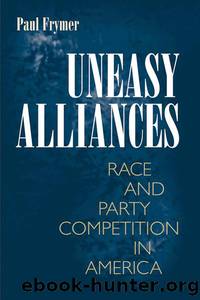Uneasy Alliances by Paul Frymer;

Author:Paul Frymer;
Language: eng
Format: epub
Publisher: Princeton University Press
Published: 1999-06-15T00:00:00+00:00
PARTY MOBILIZATION AND VOTER PARTICIPATION
There has long been a close relationship between party mobilization efforts and high participation rates. Beginning with the development of the Democratic party in the late 1820s, there have been dramatic increases in voter mobilization whenever political parties have actively sought out new constituencies.1 National turnout in presidential elections between the 1830s and 1890s hovered around 80 percent.2 On a number of occasions, parties mobilized groups with direct policy appeals. During the Populist and New Deal campaigns, as well as the Alfred E. Smith campaign in 1928, the Democratic party mobilized working-class and rural voters by putting forth substantive agenda proposals.3 On other occasions, parties have mobilized ethnic and racial minorities with promises of legislation on their behalf.4 On still other occasions, party mobilization efforts have emphasized cultural and nationalistic appeals.5
When the ability of mass parties to mobilize voters was weakened around the turn of the twentieth century, voting turnout began to decline dramatically.6 In the 1800s, when party organizations naturalized and registered scores of immigrants, there were few limitations on the partyâs ability to mobilize. By the turn of the century, barriers to voting made it increasingly difficult for working-class and poor voters to participate. Party competition was responsible for many of these barriers. Democrats and Republicans, for instance, competed (as we saw in chapter 3) to disenfranchise African Americans in the South. At the same time, northern Republicans passed strict voter registration laws in an effort to limit the Democratsâ ability to mobilize immigrant voters.7 But antipartisan movements also played their role. The Progressive movement of the early 1900s, for instance, imposed a number of barriers on the ability of party machines and organizations to continue mobilizing large portions of the mass public. Reforms of the mid-1900s further weakened the ability of the party organization to undertake mobilization efforts. While local campaigns sporadically mobilized communities of voters, national party mobilization declined and voting rates declined with it.
In recent years, however, the national party organization has had a rebirth of sorts. Parties have become increasingly influential in organizing the campaigns of congressional candidates, coordinating the advertising and mobilizing of party positions, and controlling the political agenda. They have taken back control from consultants, the media, and PACS by nationalizing their authority and centralizing fund-raising and voter registration efforts. They are taking a more active role in encouraging candidates to run for office and supplying candidates with survey data, media and other consulting services, and campaign training.8 Paul Herrnson claims that the national parties ânow assist in campaign functions requiring technical expertise, in-depth research, or connections with campaign elites that possess many of the skills and resources needed to communicate with the electorate.â9 The ability of parties to involve themselves in campaigns by providing the technology and expertise deemed necessary to win has given them a degree of leverage over campaigns that they have not had in many years.
The Democratic National Committee (DNC), for instance, now has influence over what can be called a âfamilyâ of
Download
This site does not store any files on its server. We only index and link to content provided by other sites. Please contact the content providers to delete copyright contents if any and email us, we'll remove relevant links or contents immediately.
The Secret History by Donna Tartt(18157)
The Social Justice Warrior Handbook by Lisa De Pasquale(11951)
Thirteen Reasons Why by Jay Asher(8451)
This Is How You Lose Her by Junot Diaz(6434)
Weapons of Math Destruction by Cathy O'Neil(5829)
Zero to One by Peter Thiel(5488)
Beartown by Fredrik Backman(5351)
The Myth of the Strong Leader by Archie Brown(5237)
The Fire Next Time by James Baldwin(5016)
How Democracies Die by Steven Levitsky & Daniel Ziblatt(4952)
Promise Me, Dad by Joe Biden(4908)
Stone's Rules by Roger Stone(4855)
100 Deadly Skills by Clint Emerson(4689)
A Higher Loyalty: Truth, Lies, and Leadership by James Comey(4550)
Rise and Kill First by Ronen Bergman(4544)
Secrecy World by Jake Bernstein(4388)
The David Icke Guide to the Global Conspiracy (and how to end it) by David Icke(4378)
The Farm by Tom Rob Smith(4322)
The Doomsday Machine by Daniel Ellsberg(4245)
